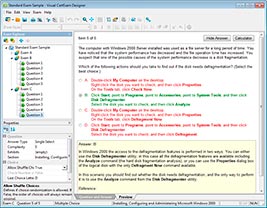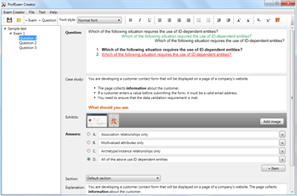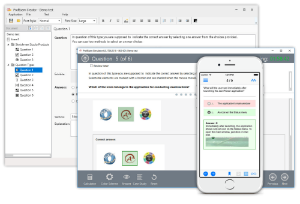Download Administering Microsoft SQL Server 2012-2014 Databases.70-462.TestInside.2018-07-25.182q.vcex
| Vendor: | Microsoft |
| Exam Code: | 70-462 |
| Exam Name: | Administering Microsoft SQL Server 2012/2014 Databases |
| Date: | Jul 25, 2018 |
| File Size: | 5 MB |
How to open VCEX files?
Files with VCEX extension can be opened by ProfExam Simulator.
Purchase
Coupon: TAURUSSIM_20OFF
Discount: 20%
Demo Questions
Question 1
You administer all the deployments of Microsoft SQL Server 2012 in your company.
You need to ensure that an OLTP database that includes up-to-the-minute reporting requirements can be off-loaded from the primary database to another server. You also need to be able to add indexes to the secondary database.
Which configuration should you use?
- Two servers configured in different data centersSQL Server Availability Group configured in Synchronous-Commit Availability ModeOne server configured as an Active Secondary
- Two servers configured in the same data centerSQL Server Availability Group configured in Asynchronous-Commit Availability ModeOne server configured as an Active Secondary
- Two servers configured in the same data centerA primary server configured to perform log-shipping every 10 minutesA backup server configured as a warm standby
- Two servers configured in different data centersSQL Server Availability Group configured in Asynchronous-Commit Availability Mode
- Two servers configured on the same subnetSQL Server Availability Group configured in Synchronous-Commit Availability Mode
- SQL Server that includes an application database configured to perform transactional replication
- SQL Server that includes an application database configured to perform snapshot replication
- Two servers configured in a Windows Failover Cluster in the same data centerSQL Server configured as a clustered instance
Correct answer: F
Explanation:
Reference:http://msdn.microsoft.com/en-us/library/jj542414.aspx Reference:
http://msdn.microsoft.com/en-us/library/jj542414.aspx
Question 2
You administer all the deployments of Microsoft SQL Server 2012 in your company.
You need to ensure that data changes are sent to a non-SQL Server database server in near real time.
You also need to ensure that data on the primary server is unaffected.
Which configuration should you use?
- SQL Server that includes an application database configured to perform transactional replication
- Two servers configured in different data centersSQL Server Availability Group configured in Asynchronous-Commit Availability Mode
- Two servers configured in different data centersSQL Server Availability Group configured in Synchronous-Commit Availability ModeOne server configured as an Active Secondary
- SQL Server that includes an application database configured to perform snapshot replication
- Two servers configured in the same data centerSQL Server Availability Group configured in Asynchronous-Commit Availability ModeOne server configured as an Active Secondary
- Two servers configured on the same subnetSQL Server Availability Group configured in Synchronous-Commit Availability Mode
- Two servers configured in a Windows Failover Cluster in the same data centerSQL Server configured as a clustered instance
- Two servers configured in the same data centerA primary server configured to perform log-shipping every 10 minutesA backup server configured as a warm standby
Correct answer: A
Explanation:
Reference:http://msdn.microsoft.com/en-us/library/ms151149.aspx Reference:
http://msdn.microsoft.com/en-us/library/ms151149.aspx
Question 3
You administer all the deployments of Microsoft SQL Server 2012 in your company.
A database contains a large product catalog that is updated periodically.
You need to be able to send the entire product catalog to all branch offices on a monthly basis.
Which configuration should you use?
- Two servers configured in the same data centerA primary server configured to perform log-shipping every 10 minutesA backup server configured as a warm standby
- SQL Server that includes an application database configured to perform transactional replication
- Two servers configured in the same data centerSQL Server Availability Group configured in Asynchronous-Commit Availability ModeOne server configured as an Active Secondary
- D Two servers configured in a Windows Failover Cluster in the same data centerSQL Server configured as a clustered instance
- SQL Server that includes an application database configured to perform snapshot replication
- Two servers configured in different data centersSQL Server Availability Group configured in Synchronous-Commit Availability ModeOne server configured as an Active Secondary
- Two servers configured on the same subnetSQL Server Availability Group configured in Synchronous-Commit Availability Mode
- Two servers configured in different data centersSQL Server Availability Group configured in Asynchronous-Commit Availability Mode
Correct answer: E
Question 4
Note: This question is part of a series of questions that use the same set of answer choices. An answer choice may be correct for more than one question in the series.
You administer all the deployments of Microsoft SQL Server in your company.
You need to ensure that an OLTP database that uses a storage area network (SAN) remains available if any of the servers fail.
You also need to minimize the amount of storage used by the database.
Which configuration should you use?
- Two servers configured in different data centersSQL Server Availability Group configured in Synchronous-Commit Availability ModeOne server configured as an Active Secondary
- SQL Server that includes an application database configured to perform transactional replication
- Two servers configured in the same data centerSQL Server Availability Group configured in Asynchronous-Commit Availability ModeOne server configured as an Active Secondary
- Two servers configured in different data centersSQL Server Availability Group configured in Asynchronous-Commit Availability Mode
- Two servers configured in the same data centerA primary server configured to perform log-shipping every 10 minutesA backup server configured as a warm standby
- Two servers configured on the same subnetSQL Server Availability Group configured in Synchronous-Commit Availability Mode
- SQL Server that includes an application database configured to perform snapshot replication
- Two servers configured in a Windows Failover Cluster in the same data centerSQL Server configured as a clustered instance
Correct answer: H
Question 5
Note: This question is part of a series of questions that use the same set of answers choices. An answer choice may be correct for more than one question in the series.
You administer a Microsoft SQL Server server that hosts a transactional database and a reporting database. The transactional database is updated through a web application and is operational throughout the day. The reporting database is only updated from the transactional database.
The recovery model and backup schedule are configured as shown in the following table:

The differential backup of the reporting database fails. Then, the reporting database fails at 14:00 hours.
You need to ensure that the reporting database is restored. You also need to ensure that data loss is minimal.
What should you do?
- Restore the latest full backup, and restore the latest differential backup. Then, restore the latest log backup.
- Perform a point-in-time restore.
- Restore the latest full backup.
- Restore the latest full backup, and restore the latest differential backup. Then, restore each log backup taken before the time of failure from the most recent differential backup.
- Restore the latest full backup. Then, restore the latest differential backup.
- Restore the latest full backup. Then, restore each differential backup taken before the time of failure from the most recent full backup.
- Perform a page restore.
- Perform a partial restore.
Correct answer: C
Question 6
Note: This question is part of a series of questions that use the same set of answers choices. An answer choice may be correct for more than one question in the series.
You administer a Microsoft SQL Server server that hosts a transactional database and a reporting database. The transactional database is updated through a web application and is operational throughout the day. The reporting database is only updated from the transactional database.
The recovery model and backup schedule are configured as shown in the following table:

At 14:00 hours, you discover that pages 71, 520, and 713 on one of the database files are corrupted on the reporting database.
You also need to ensure that data loss is minimal.
What should you do?
- Perform a partial restore.
- Restore the latest full backup, and restore the latest differential backup. Then, restore each log backup taken before the time of failure from the most recent differential backup.
- Restore the latest full backup.
- Restore the latest full backup, and restore the latest differential backup. Then, restore the latest log backup.
- Perform a page restore.
- Restore the latest full backup. Then, restore each differential backup taken before the time of failure from the most recent full backup.
- Perform a point-in-time restore.
- Restore the latest full backup. Then, restore the latest differential backup.
Correct answer: H
Explanation:
Restores a file or filegroup in a multi-filegroup database. Note that under the simple recovery model, the file must belong to a read-only filegroup. After a full file restore, a differential file backup can be restored. Page restore Restores individual pages. Page restore is available only under the full and bulk-logged recovery models. Piecemeal restore Restores the database in stages, beginning with the primary filegroup and one or more secondary filegroups. A piecemeal restore begins with a RESTORE DATABASE using the PARTIAL option and specifying one or more secondary filegroups to be restored. Restores a file or filegroup in a multi-filegroup database. Note that under the simple recovery model, the file must belong to a read-only filegroup. After a full file restore, a differential file backup can be restored.
Page restore
Restores individual pages. Page restore is available only under the full and bulk-logged recovery models.
Piecemeal restore
Restores the database in stages, beginning with the primary filegroup and one or more secondary filegroups. A piecemeal restore begins with a RESTORE DATABASE using the PARTIAL option and specifying one or more secondary filegroups to be restored.
Question 7
You administer two instances of Microsoft SQL Server 2012. You deploy an application that uses a database on the named instance.
The application is unable to connect to the database on the named instance.
You need to ensure that the application can connect to the named instance.
What should you do?
- Use the Data Quality Client to configure the application.
- Start the SQL Server Browser Service.
- Use the Master Data Services Configuration Manager to configure the application.
- Start the SQL Server Integration Services Service.
Correct answer: B
Question 8
You administer a Microsoft SQL Server database. The database has a table named Customers owned by UserA and another table named Orders owned by UserB. You also have a stored procedure named GetCustomerOrderInfo owned by UserB. GetCustomerOrderInfo selects data from both tables.
You create a new user named UserC.
You need to ensure that UserC can call the GetCustomerOrderInfo stored procedure. You also need to assign only the minimum required permissions to UserC.
Which permission or permissions should you assign to UserC? Each correct answer presents part of the solution.
- The Select permission on Customers
- The Execute permission on GetCustomerOrderInfo
- The Take Ownership permission on Customers
- The Control permission on GetCustomerOrderInfo
- The Take Ownership permission on Orders
- The Select permission on Orders
Correct answer: B
Explanation:
How Permissions Are Checked in a Chain When an object is accessed through a chain, SQL Server first compares the owner of the object to the owner of the calling object. This is the previous link in the chain. If both objects have the same owner, permissions on the referenced object are not evaluated. Due to ownership chaining, you would only need to give Execute permissions to UserC to access the Orders table since UserB is the owner. References: https://technet.microsoft.com/en-us/library/ms188676(v=sql.105).aspx How Permissions Are Checked in a Chain
When an object is accessed through a chain, SQL Server first compares the owner of the object to the owner of the calling object. This is the previous link in the chain. If both objects have the same owner, permissions on the referenced object are not evaluated.
Due to ownership chaining, you would only need to give Execute permissions to UserC to access the Orders table since UserB is the owner.
References: https://technet.microsoft.com/en-us/library/ms188676(v=sql.105).aspx
Question 9
You administer a Microsoft SQL Server 2012 database named ContosoDB. The database contains a table named Suppliers and a column named IsActive in the Purchases schemA.
You create a new user named ContosoUser in ContosoDB. ContosoUser has no permissions to the Suppliers table.
You need to ensure that ContosoUser can delete rows that are not active from Suppliers. You also need to grant ContosoUser only the minimum required permissions.
Which Transact-SQL statement should you use?
Correct answer: D
Explanation:
Incorrect:Not B: The dbo , or database owner, is a user account that has implied permissions to perform all activities in the database. This would go against the requirement to grant ContosoUser only the minimum required permissions.References:http://msdn.microsoft.com/en-us/library/ms188354.aspxhttp://msdn.microsoft.com/en-us/library/ms187926.aspx Incorrect:
Not B: The dbo , or database owner, is a user account that has implied permissions to perform all activities in the database. This would go against the requirement to grant ContosoUser only the minimum required permissions.
References:
http://msdn.microsoft.com/en-us/library/ms188354.aspx
http://msdn.microsoft.com/en-us/library/ms187926.aspx
Question 10
You use a contained database named ContosoDb within a domain.
You need to create a user who can log on to the ContosoDb database. You also need to ensure that you can port the database to different database servers within the domain without additional user account configurations.
Which type of user should you create?
- User mapped to a certificate
- SQL user without login
- Domain user
- SQL user with login
Correct answer: C
Explanation:
Contained user There are two types of users for contained databases. Contained database user with password Contained database users with passwords are authenticated by the database. Windows principals Authorized Windows users and members of authorized Windows groups can connect directly to the database and do not need logins in the master database. The database trusts the authentication by Windows. References: https://docs.microsoft.com/en-us/sql/relational-databases/databases/contained-databases?view=sql-server-2017 Contained user
There are two types of users for contained databases.
Contained database user with password
Contained database users with passwords are authenticated by the database.
Windows principals
Authorized Windows users and members of authorized Windows groups can connect directly to the database and do not need logins in the master database.
The database trusts the authentication by Windows.
References: https://docs.microsoft.com/en-us/sql/relational-databases/databases/contained-databases?view=sql-server-2017
HOW TO OPEN VCE FILES
Use VCE Exam Simulator to open VCE files

HOW TO OPEN VCEX FILES
Use ProfExam Simulator to open VCEX files


ProfExam at a 20% markdown
You have the opportunity to purchase ProfExam at a 20% reduced price
Get Now!







